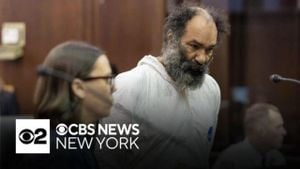For fans eager for fresh adventures from the galaxy far, far away, the announcement of a new trilogy of Star Wars films has stirred excitement and debate alike. Simon Kinberg, known for his work on the X-Men franchise, is set to write and produce this fresh installment, marking Kinberg's return to the Star Wars universe after co-creating the animated series Star Wars: Rebels. This news, confirmed by industry sources, could signal the start of Episodes 10, 11, and 12, but key details remain shrouded in mystery.
After nearly five years since The Rise of Skywalker was released, this new trilogy has emerged during what many fans might term as the golden era of Star Wars storytelling. Lucasfilm, under the guidance of Kathleen Kennedy, is hoping this trilogy will add to the franchise’s vibrant narrative portfolio. Despite the massive anticipation, the exact nature of the upcoming films is still uncertain. Insiders have shared contrasting opinions, with some asserting the new saga will extend the Skywalker narrative, whereas others claim Kinberg's films will be self-contained, exploring new characters and stories away from the beloved legacy.
The Skywalker Saga, which started with 1977’s A New Hope, has been touted as ending with The Rise of Skywalker, leaving many fans wondering if revisiting this iconic tale is necessary or desirable. Kinberg's films have yet to find their footing, and industry insiders stress they are still very much in the development stages. It’s clear, though, their ambition is to create something compelling and distinctive.
Representatives from Lucasfilm have emphasized the speculative nature of initial reports, particularly those claiming the trilogy is certain to be labeled as Episodes 10-12. They noted the potential for these new entries to focus on untold stories within the Star Wars universe, which might include settings and protagonists unfamiliar to audiences.
Daisy Ridley, famous for her role as Rey, is confirmed to be involved in Star Wars projects still underway. Whether her character will also connect to Kinberg's trilogy remains ambiguous, adding to the intriguing possibilities. There are whispers about her returning for another adventure, but it’s too early to predict how these narratives might intertwine.
What continues to reverberate among Star Wars circles is the question of how the franchise can maintain relevance and enthusiasm without retracing old ground. Fans have had mixed reactions to the previous trilogy, with many clamoring for innovation over nostalgia. Kinberg himself faces the challenge of crafting stories capable of rekindling interest and appeasing the longtime fan base who has disagreed with recent storytelling directions.
Star Wars has proven to be divisive among its community; some loyalists believe it needs to boldly venture away from the established Skywalker lore, effectively finding fresh ground to tread. Others, perhaps more nostalgic, appreciate the familiar themes and characters interwoven throughout its expansive lore. This duality presents Kinberg with unique creative hurdles, as blending innovation with established Star Wars entities can either lead to groundbreaking cinema or drawn-out mediocrity.
Industry experts suggest the groundwork is certainly there for Kinberg to learn from the Disney era of storytelling. Notably, The Mandalorian has embraced episodic storytelling, exploring rich character arcs beyond the Skywalker lineage and garnering massive fandom enthusiasm predominantly thanks to some smart writing choices and well-received star performances.
Fans are also eager for lessons from past mistakes, particularly those stemming from The Last Jedi and The Rise of Skywalker, where the narrative choices division among viewers left both casual and hardcore fans disgruntled. The unique backlash points to the necessity for any new entries to comprehend the broader conversation surrounding the Star Wars mythos, ideally fostering perspectives and even protagonists from diverse backgrounds.
There are also hopes within the fandom community for Kinberg’s trilogy to veer away from over-reliance on nostalgia. While many enjoyed cameos and appearances from legacy characters, there’s also potential for the franchise to focus on stories separate from the established Skywalker narrative, creating new mythology with unique heroes and villains. The power of storytelling lies not only with the iconic lightsaber duels and space battles but also within the feeling of wonder and possibility the Star Wars universe inherently offers.
Precedent for stand-alone narratives showcases how the Star Wars galaxy is expansive, with complex storylines thriving when divorced from legacy characters. Projects like Rogue One and The Bad Batch embraced this exploratory spirit, and continued success with these strategies could be pivotal for Kinberg’s new undertaking.
The stakes are high, but the potential is limitless as Lucasfilm prepares to bring Star Wars back to theaters. For Kinberg, the pressure is on—balancing audience expectations and the need for innovation will be key to his success. Exploring the unique stories only Star Wars can tell, rather than duplications of what’s already known, could set the stage for unprecedented cinematic experiences.
What remains clear is the notion of hope—a common thread for Star Wars. Fans are ready for something new, and Kinberg’s hiring is indicative of Lucasfilm’s intent to reinvigorate the franchise. Whether this new trilogy finds itself rooted deeply within the Skywalker Saga or blossoms as something uncovered and wholly new, the excitement surrounding the announcement reflects the enduring legacy of Star Wars and its dedicated fan base.



